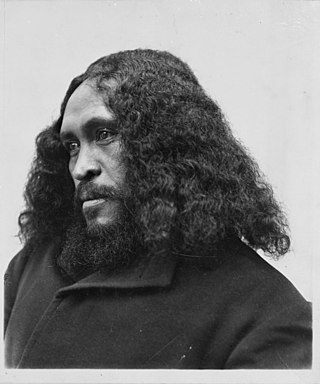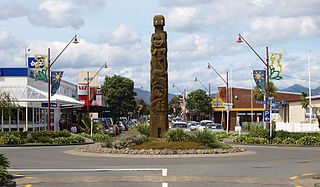
Ropata Wahawaha was a Māori military leader and rangatira (chief) of the Ngāti Porou iwi (tribe) who rose to prominence during New Zealand's East Cape War and Te Kooti's War.

Te Urewera National Park was a national park near the east coast of New Zealand's North Island, established as such in 1954 and disestablished in 2014, when it was replaced by a new legal entity and protected area named Te Urewera. The park covered an area of approximately 2,127 km2 and was located in the north of the Hawke's Bay region of the North Island. It was the largest of four national parks in the North Island and the most isolated rainforest in the region.

Ruatāhuna is a small town in the remote country of Te Urewera, in the northeast of New Zealand's North Island. It is 90 kilometres directly west of Gisborne, and 18 kilometres northwest of Lake Waikaremoana. By road, it is 50 kilometres south-east of Murupara, and 110 kilometres north-west of Wairoa. It is on the upper reaches of the Whakatāne River, and surrounded on three sides by the Te Urewera protected area, formerly the Te Urewera National Park. The road that runs from Murupara through Ruatahuna to Āniwaniwa on Lake Waikaremoana, a large part of which is unsealed, used to be designated as part of State Highway 38. It is a subdivision of the Galatea-Murupara ward of the Whakatāne District.

Lake Waikaremoana is located in Te Urewera in the North Island of New Zealand, 60 kilometres northwest of Wairoa and 80 kilometres west-southwest of Gisborne. It covers an area of 54 km2 (21 sq mi). From the Māori Waikaremoana translates as 'sea of rippling waters'.

Ngāi Tūhoe, often known simply as Tūhoe, is a Māori iwi of New Zealand. It takes its name from an ancestral figure, Tūhoe-pōtiki. Tūhoe is a Māori-language word meaning "steep" or "high noon". Tūhoe people also bear the sobriquet Nga Tamariki o te Kohu. Tūhoe traditional land is at Te Urewera in the eastern North Island, a steep, heavily forested area which includes Lake Waikaremoana. Tūhoe traditionally relied on the forest for their needs. The tribe had its main centres of population in the small mountain valleys of Ahikereru and Ruatāhuna, with Maungapohatu, the inner sanctum of the Urewera, as their sacred mountain. The Tūhoe country had a great reputation among the neighbouring tribes as a graveyard for invading forces.

Protected areas of New Zealand are areas that are in some way protected to preserve their environmental, scientific, scenic, historical, cultural or recreational value. There are about 10,000 protected areas, covering about a third of the country. The method and aims of protection vary according to the importance of the resource and whether it is publicly or privately owned.

Tāme Wairere Iti is a New Zealand Māori activist, artist, actor and social worker. Of Ngāi Tūhoe descent, Iti rose to prominence as a member of the protest group Ngā Tamatoa in 1970s Auckland, becoming a key figure of the Māori protest movement and the Māori renaissance. Since then, he has become a renowned activist for the rights of Māori and the process of co-governance and decolonisation.

Tāneatua is a small town in the Bay of Plenty region of New Zealand's North Island, 13 kilometres south of Whakatāne. State Highway 2 passes through the town on its route between Edgecumbe and Ōpōtiki. The small settlements of Ruatoki and Waimana are to the south and south-east of Tāneatua.
The Māori protest movement is a broad indigenous rights movement in New Zealand. While there was a range of conflicts between Māori and European immigrants prior to the signing of the Treaty of Waitangi in 1840, the signing provided one reason for protesting. Disagreements in the decades following the signing sometimes included war.

Rua Kenana Hepetipa or Rua Kēnana Hepetipa was a Māori prophet, faith healer and land rights activist. He called himself Te Mihaia Hou, the New Messiah, and claimed to be Te Kooti Arikirangi's successor Hepetipa (Hephzibah) who would reclaim Tūhoe land that had been lost to Pākehā ownership. Rua's beliefs split the Ringatū Church, which Te Kooti had founded in around 1866/1868. In 1907 Rua formed a non-violent religious community at Maungapōhatu, the sacred mountain of Ngāi Tūhoe, in the Urewera. By 1900, Maungapōhatu was one of the few areas that had not been investigated by the Native Land Court. The community, also known as New Jerusalem, included a farming co-operative and a savings bank. Many Pākehā believed the community was subversive and saw Rua as a disruptive influence.

The 2007 New Zealand police raids were a series of armed police raids conducted on 15 and 16 October 2007, in response to alleged paramilitary training camps in the Urewera mountain range near the town of Ruatoki. About 300 police, including members of the Armed Offenders Squad and Special Tactics Group, were involved in the raids, which involved the execution of search warrants at various addresses throughout New Zealand, and the establishment of roadblocks at Ruatoki and Tāneatua. The police seized four guns and 230 rounds of ammunition and arrested eighteen people. According to police, the raids were a culmination of more than a year of surveillance that uncovered and monitored the training camps.
Ruatoki North is a town in the eastern Bay of Plenty of New Zealand, just south of the small town of Tāneatua and approximately 20 km south of the city of Whakatāne. The Whakatāne River runs northwards through the Ruatoki Valley and has formed broad alluvial flats. The main settlement of Ruatoki North is on the eastern side of the river.
Te Wharekura o Ruatoki is a rural school in the Māori settlement of Ruatoki in the Eastern Bay of Plenty region, New Zealand, serving children in years 1 through 13. It was established as Ruatoki Native School in 1896 after a visit by Richard Seddon and James Carroll. In 1978 it became New Zealand’s first officially bilingual school.
Te Hui Ahurei a Tūhoe is a festival that was created in 1971 by John Rangihau for the Iwi nation Ngāi Tūhoe. Kapa haka teams that come from the Iwi nation perform and Tūhoe people gather to celebrate.

Sir William Te Rangiua "Pou" Temara is a New Zealand academic. He is professor of Māori language and tikanga Māori (practices) at Waikato University and a cultural authority on whaikōrero (oratory), whakapapa (genealogy) and karakia. Prior to working at Waikato, he taught at Victoria University of Wellington, where he also studied, and at Te Whare Wānanga o Awanuiārangi.
Waimana is a rural valley in the Whakatāne District and Bay of Plenty Region of New Zealand's North Island. It is located in the northern Te Urewera. Waimana River, originally known as Tauranga River, runs through the valley, joining the Ohinemataroa River one kilometre south-west of Tāneatua.
Matahi is a rural valley in the Whakatāne District and Bay of Plenty Region of New Zealand's North Island.

Te Whakatōhea is a Māori iwi of the eastern Bay of Plenty region of New Zealand. Their traditional territory extends along the coastline eastwards from Ōhiwa Harbour to Opape, and inland to Mātāwai, and is centred in the area around the town of Ōpōtiki. These lands have long held an abundance of food resources, particularly seafood. All their historical pā were situated near the coast, to defend the marine resources.
Maungapohatu is a settlement in the Bay of Plenty Region of New Zealand's North Island. Located in a remote area of the Urewera bush country about 20 kilometres (12 mi) north of Lake Waikaremoana, it was founded by Rua Tapunui Kenana in 1907 and was substantially rebuilt twice during the next two decades. At its peak more than 500 people lived there but today it is once more a very sparsely populated place.

The Rua Kēnana Pardon Act 2019 is a statute in the New Zealand Parliament that provides a pardon for the Tūhoe prophet Rua Kēnana (1869–1937).












